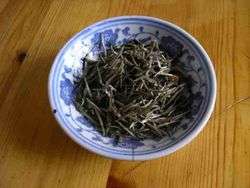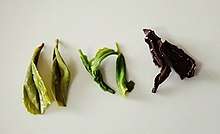Yellow tea can refer to Chinese huángchá (黄茶; 黃茶) and Korean hwangcha (황차; 黃茶).[1][2]
Chinese huangcha
It is an increasingly rare and expensive variety of tea.[3]:58 The process for making yellow tea is similar to that of green but with an added step of encasing and steaming the tea. This allows the tea to oxidize at a slower rate, producing a far more mellow taste than is found in most green teas [4]; this also gives the leaves a slightly yellow colouring during the drying process.[3]:32[4] Yellow tea is often placed in the same category with green tea due to its light oxidation. One of the primary aims of making yellow tea is to remove the characteristic grassy smell of green tea while preserving the associated health qualities of green tea. Some have even speculated that yellow tea may be healthier because it is easier on the stomach than green tea.[5]
Korean hwangcha
In Korean tea terminology wherein domestic tea is categorized mainly as either green tea (nokcha; 녹차) or fermented tea (balhyocha; 발효차) – "fermented" practically meaning "oxidized" with this term[6] – "yellow tea" (hwangcha) is used to denote lightly oxidized balhyocha without implications of processing methods or a result that would qualify the tea as "yellow tea" in the Chinese definition.[6] Unlike Chinese huángchá, Korean hwangcha is made similarly to oolong tea or lightly oxidized black tea, depending on who makes it – the key feature is a noticeable but otherwise relatively low level of oxidation which leaves the resulting tea liquor yellow in color.
Tea leaves:
sejak (green tea),
ujeon (green tea),
hwangcha (yellow tea)
Hwangcha
infusing hwangcha
References
- ↑ "黄茶" [huángchá]. LINE Dictionary. Naver Corporation. Retrieved 28 January 2017.
- ↑ "hwangcha" 황차 [yellow tea]. Standard Korean Language Dictionary (in Korean). National Institute of Korean Language. Retrieved 28 January 2017.
- 1 2 Gascoyne, Kevin; Marchand, François; Desharnais, Jasmin; Americi, Hugo (2011). Tea: History, Terroirs, Varieties. Richmond Hill, ON: Firefly Books. ISBN 9781554079377.
- ↑ Wang, Qiang; Zhao, Xin; Qian, Yu; Wang, Rui (2013). "In vitro antioxidative activity of yellow tea and its in vivo preventive effect on gastric injury". Experimental and Therapeutic Medicine. 6 (2): 423–426. doi:10.3892/etm.2013.1117. ISSN 1792-0981. PMC 3786828.
- ↑ "Seven Cups Fine Chinese Tea - Yellow tea".
- 1 2 Gebely, Tony (7 December 2013). "South Korean Balhyocha & Hwangcha". World of Tea. Retrieved 28 January 2017.
|
|---|
Common
varieties | |
|---|
| General | |
|---|
| Culture | |
|---|
| History | |
|---|
Production and
distribution |
|
|---|
| Preparation | |
|---|
| Health | |
|---|
Tea-based
drinks | |
|---|
| See also | |
|---|
 Category:Tea Category:Tea Drink Portal Drink Portal Coffee & Tea Task Force Coffee & Tea Task Force
|

 Junshan Yinzhen, a famous Chinese tea
Junshan Yinzhen, a famous Chinese tea
.jpg) Hadong hwangcha
Hadong hwangcha Hwangcha
Hwangcha.jpg) infusing hwangcha
infusing hwangcha